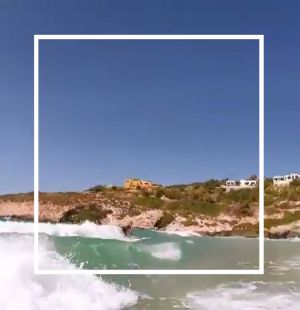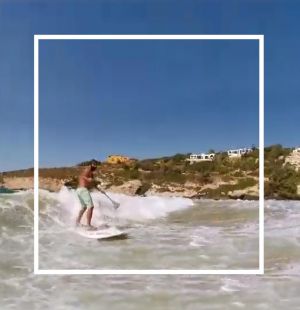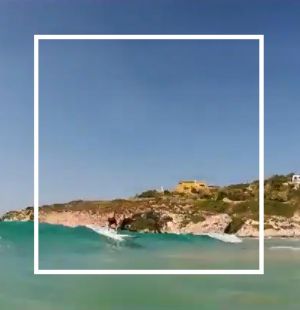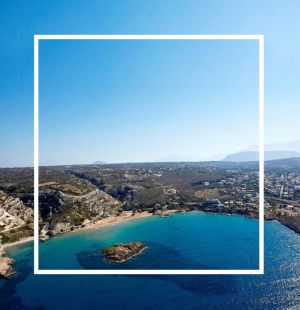Popularity: Not Much
Style: Freeride
Level: Beginner
The relatively modern, seaside village of Kalathas is located in the heart of a large natural bay on the Akrotiri peninsula, 11 km northeast of Chania. It has been inhabited by residents of Chania who wanted to live away from the city center.
Kalathas is a nice spot to windsurf, kitesurf and surf, as the beach is open to the north winds.
Quality: Crystal Clear
Depth: Shallow (walking several steps not to step on)
Seabed: Sand
Attention:
Crystal clear water. The place is ideal for beginners. The sea is too shallow up to the opposite islet so the wave cannot gain height.
Size: Medium
Bathers Period: June, July, August
Bathers: Average
Shade: Sparse
Kid Friendly: Yes
Attention:
The beautiful beach in front of the village is made by fine sand. Both ends of the beach are rocky. It is quite long (it has 220 m length), and the more likely is that you will not feel crowded. Next to the beach there are several palm trees that give an exotic tone to the landscape. It is an ideal place for an enjoyable relaxing family holiday.
Arrival on Kalathas:
Kalathas Beach in Crete is one of the western beaches of the Akrotiri Peninsula in Chania. It is located 10 km from the town of Chania, among the hills of the west coast of Akrotiri.
The beach is very well connected with the city of Chania on regular bus routes. The beach can also reach someone by taxi and by private or rented cars or motorbikes. The road that connects Chania with the northernmost village of Akrotiri, Stavros, will bring you to the beach of Kalathas.
Access to Crete:
Arrival by Airplane: Millions of visitors come to Crete every year from all over the world directly by plane, especially by charter. The three international airports on the island, in Heraklion, Chania and Sitia are linked to hundreds of other international airports. The largest low cost companies have regular flights to Crete and the most important international airlines organize charter flights. If you take your own equipment, it’s best to reserve this in advance.
Airport at Heraklion: It is the primary airport on the island of Crete and the country’s second busiest airport after Athens International Airport. It is located about 5 km east of the main city center of Heraklion, near the municipality of Nea Halicarnassus. It is a shared civil/military facility. The airport is named after Heraklion native Nikos Kazantzakis, a Greek writer and philosopher. Nikos Kazantzakis Airport is Crete’s main and busiest airport, serving Heraklion, Agios Nikolaos, Malia, Hersonissos, Stalida, Elounda and other resorts.
Airport at Chania: Located on the Northwestern part of the island, the airport is also known as the “K. Daskalogiannis” Airport. This international airport is situated near Souda Bay, on the peninsula of Akrotiri, serving the city of Chania (14 km away). Moreover, it is a gateway to western Crete for an increasing amount of tourists. It is a joint civil–military airport. It is much smaller and far less busy than Heraklion airport. The airport is connected with many countries (about 30) from Europe and Asia especially in summer season and with flights connections in Greece and Cyprus whole year.
A new public airport in Sitia: it is a small community airport in the region Bonda of Sitia Municipality, on the eastern part of Crete, located 1 km north/northwest of the city center. The facility is serving the city of Sitia, currently only with a small number of domestic flights, mainly to/from Athens International Airport Eleftherios Venizelos with an internal flight. The flight time from Athens to Sitia is 55 minutes. Also from Rhodes Island, with stops Karpathos and Kassos flight time and 120 minutes. Fly from Alexandroupolis during 105 minutes, from Preveza to over 100 minutes and from Heraklion during 25 minutes.
Inland airport at Kasteli: There are long term plans to replace Heraklion airport, which is too close to the city, by a new inland airport at Kasteli, southeast of Heraklion. It is a small airport located at the edge of Heraklion. It has basic facilities and a small parking lot.
Almost all scheduled international flights transit through Athens (which take about 45min) where you must take a scheduled domestic flight to Chania or Heraklion. These are quite frequent (around 6 to 8 times a day to Chania and more to Heraklion). During the months of July and August there are flights from Thessaloniki to Heraklion and Chania (they take about 90 minutes). The airport at Heraklion also has daily flights to Rhodes which takes 1 hour. From April till early November charter airlines fly directly to Heraklion and Chania from many European airports.
Arrival by Ferry/Boat: If you are already in Greece and specifically in Athens, you can continue your journey to Crete not only by plane but even by ferryboat from Piraeus. Athens airport offers good public transport connections to the city center as well as to the port of Piraeus. The three biggest ports of Crete, Heraklion, Rethymno and Chania have dozens of luxury ferry boats linking them with Greece’s largest port, Piraeus, on a daily basis. You can also go from Piraeus to Crete to Agios Nikolaos or Sitia Ports and from Thessaloniki to Heraklion.
The regular ferryboat service from the port of Piraeus to Heraklion and Chania is that ships depart every evening around 8.00 or 8.30 (times vary a little depending on the season) and arrive very early morning (generally between 5.00 or 6.00 am). Avoid weekends and especially the beginning and end of holidays. If you want a cabin it is often safer to book in advance.
Ferryboat from Peloponnese: South Peloponnese (Gythion, Neapolis or Kalamata) and Kythira Island is connecting to Kastelli/Kissamos (45 km west of Chania). Timetables are rather erratic (and very difficult to find) but it is an option if you want to spend time on the Peloponnese or simply avoid Athens.
Ferryboat from Cyclades and Dodecanese: From April to October you can also get boats from Cycladic Islands to Heraklion and Agios Nikolaos. There are daily catamarans (hydrofoils) to Santorini and the trip takes about 2,5 hours. Also Rhodes, Karpathos, Kasos and Milos from the ports of Sitia, Agios Nikolaos and Kissamos.
Since there are no roads along the southwest coast there is a ferry line with connections between Paleochora, Sougia, Agia Roumeli, Loutro and Hora Sfakion (Sfakia). There is also a connection with the islet of Gavdos, Europe's southernmost point (Cape Trypiti).
Ferryboat from Italy: Several shipping companies connect Italy (Trieste, Ancona, Bari, and Brindisi) with the mainland of Greece (Patras and Igoumenitsa). It is preferable to book your passage in advance in the summer season.
Arrival by Car, Moto, Camper Van: Be careful when driving in Crete; despite the fact that most roads (including the new National Highway) are full of twists and turns through mountains, Cretans usually drive aggressively, fast, and on the edge of safety. In rural and mountainous areas (which is almost everywhere), there can be goats, sheep, donkeys, and stray dogs on the roads.
Overland to Greece: Traveling to Greece overland has virtually stopped since the disintegration of former Yugoslavia. The alternative through Hungary, Romania and Bulgaria takes so long that it is not worth thinking about unless you want to visit these countries. The only option if you want to come by car or bike is by ferry from Italy.
For those who don’t have their own means of transport, there is of course always the possibility to rent a car or a camper which will allow you to explore the island on its modern network of roads. Taxi services are another way to get around Crete, but can be quite expensive.
Arrival by Bus: Most of the bus services are run by KTEL (around 200 intercity modern buses of all sizes) conducts hundreds of routes daily, thus linking the major cities of the island with all the settlements, but also with the rest of Greece within a framework of combined transportations. Public transportation is fairly frequent and timetables quite trustworthy. Bus drivers usually divert from their marked routes to enter little villages if asked to do so. Bus services along the north coast and towards the south coast are excellent, reliable, frequent and cheap.
Cretan bus stations are very simple for the most part, except for in Heraklion which has two major bus stations (one for buses going in town and one for KTEL run buses).
On foot: Although Crete is the largest of all Greek islands; you can get around on foot. Especially the countryside in the western part of Crete offers some rough country walking and there are good paths between Chania and Chora Sfakion. These go via forests with cypress, evergreen oak and cypress, various gorges and of course olive and orange groves. This part of Crete is good for walking holidays.
 Windsurf Rental
Windsurf Rental
 Kitesurf Lessons
Kitesurf Lessons
 Kitesurf Rental
Kitesurf Rental
 Surf Lessons
Surf Lessons
 Surf Rental
Surf Rental
 SUP Rental
SUP Rental
 Rescue
Rescue
Life guarding services Equipment Store
Equipment Store
 Events
Events
 Parking
Parking
Parking along the beach is available in the area Toilet
Toilet
 Shower
Shower
 Beach facilities
Beach facilities
The beach is very well organized with umbrellas Food
Food
A canteen & a restaurant Market
Market
 Acommodations
Acommodations
Hotels & Rooms Medical Center
Medical Center
Regional Clinic in Aroni (11 km away) & General Hospital in Chania (17 km away) More Activities
More Activities
Waterskiing, Water Games, Canoes, Scuba Diving, Beach Volley

.jpg)
.jpg)
.jpg)
.jpg)
.jpg)
.jpg)





.jpg)
.jpg)